|
|
|
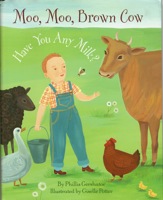
|
Moo, Moo, Brown Cow,
Have You Any Milk?
illustrated
by Giselle Potter
Random House, 2011
|
*E-Book
also
available!
ISBN:
9780375988714
Format:
EL/ePub
|
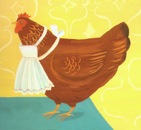
|
| From
the book jacket: |
|
Moo, moo, Brown Cow,
have
you any milk?
Yes,
sir, yes, sir,
smooth
as silk.
Will
milk make me sleepy
before
I go to bed?
Yes,
sir, yes, sir,
the
brown cow said.
Say that again? Yes, you
heard right. There’s something
different going on with this
well-loved nursery rhyme. Besides
offering clever twists and charming
new critters, this sweet retelling
of “Baa, Baa, Black Sheep” gently
teachers young listeners something
along the way as a plucky little boy
asks his farm friends about the
gifts they give us.
And as the
animals prepare to “dream the whole
night through of flowers to sip,
grass to chew,” the little boy asks
them one last question.
Whether read aloud or sung, Phillis
Gershator’s melodic rhyme with
Giselle Potter’s folksy
illustrations, can be appreciated as
a rollicking tale or a perfect
lulling bedtime story.
|
A little about the book:
|
I’ve
always
been
inspired
by
books
about
“process”––how
is
a
blanket
made?
A pillow? Honey, milk, bread? And
I’ve always been inspired by
traditional rhymes. In Moo, Moo,
Brown Cow I had a chance to
combine the two!
I also like
picture books that allow for
repeated reading and exploring. In Moo, Moo
a young child can explore
colors––not only the repeated colors
of the animals but the purple flowers,
green grass,
blue chicken coop.... Some other
talking points for a young audience:
What sounds
do other farm animals make––cats,
dogs, horses, goats, ducks? Where does our
food come from? (Other than the
supermarket!) What would a dog dream
about, or a goose, or a cow?
Children with masks (or children
using puppets) might have fun
performing Moo,
Moo as a playlet. If there
a lot of children, the "extras"
could include more farm animals and
even an animal chorus.
To
sing along with the traditional tune
for "Baa, Baa, Black Sheep," a
parent or teacher could also add
additional sing-song animal sounds
for each animal, or expand the text
with additional, repetitive verses
for the sheep, goose, hen, bee.
Here is the first part
of the text, with some suggested
additional verses in italics, along
with pictures in the illustrator's
style, just for fun:
Baa, baa,
black sheep,
have you any
wool?
“Yes, sir,
yes, sir,
three bags
full.”
Does wool make
a blanket
for my bed?
“Yes, sir,
yes, sir,”
the black
sheep said.
Thank you
for the wool
and blanket
for my bed.
“You are
very welcome,”
the black
sheep said.
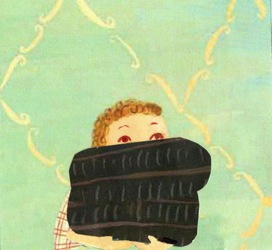 [alternative
or in addition:
Baa baa baa
baa
baa baa baa
baa.
Baa baa baa
baa,
baa baa
baa.]
Honk, honk,
grey goose,
have you any
down?
“Yes, sir,
yes, sir,”
half a pound.
Does down make
a pillow
for my head?
“Yes, sir,
yes, sir,”
the gray goose
said.
Thank you
for the down
and pillow
for my head.
“You are
very welcome,”
the gray
goose said.
[alternative
or in addition:
Baa baa baa
baa
baa baa baa
baa.
Baa baa baa
baa,
baa baa
baa.]
Honk, honk,
grey goose,
have you any
down?
“Yes, sir,
yes, sir,”
half a pound.
Does down make
a pillow
for my head?
“Yes, sir,
yes, sir,”
the gray goose
said.
Thank you
for the down
and pillow
for my head.
“You are
very welcome,”
the gray
goose said.
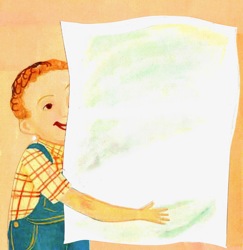 [alternative
or in addition:
Honk honk
honk honk, etc.]
Cluck, cluck,
red hen,
have you eggs
for me?
“Yes, sir,
yes, sir,
one, two,
three.”
Do eggs and
flour
make a loaf of
bread?
“Yes, sir,
yes, sir,”
the red hen
said.
Thank you
for the eggs
and the
loaf of bread.
“You are
very welcome,”
the red hen
said.
[alternative
or in addition:
Honk honk
honk honk, etc.]
Cluck, cluck,
red hen,
have you eggs
for me?
“Yes, sir,
yes, sir,
one, two,
three.”
Do eggs and
flour
make a loaf of
bread?
“Yes, sir,
yes, sir,”
the red hen
said.
Thank you
for the eggs
and the
loaf of bread.
“You are
very welcome,”
the red hen
said.
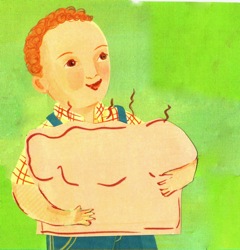 [alternative
or in addition:
Cluck cluck
cluck cluck, etc.]
Buzz, buzz,
yellow bee,
have you any
honey?
“Yes, sir,
yes, sir,
sweet and
sunny.”
Does sun-sweet
honey
make a tasty
spread?
“Yes, sir,
yes, sir,”
the yellow bee
said.
Thank you
for the honey
and the
tasty spread.
“You are
very welcome,”
the yellow
bee said.
[alternative
or in addition:
Cluck cluck
cluck cluck, etc.]
Buzz, buzz,
yellow bee,
have you any
honey?
“Yes, sir,
yes, sir,
sweet and
sunny.”
Does sun-sweet
honey
make a tasty
spread?
“Yes, sir,
yes, sir,”
the yellow bee
said.
Thank you
for the honey
and the
tasty spread.
“You are
very welcome,”
the yellow
bee said.
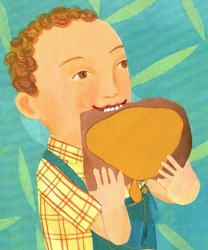 [alternative
or in addition:
Buzz buzz
buzz buzz, etc.]
Moo, moo,
brown cow,
have you any
milk?
“Yes, sir,
yes, sir,
smooth as
silk.”
Does milk make
me sleepy
before I go to
bed?
“Yes, sir,
yes, sir,”
the brown cow
said.
Thank you
for the milk,
so creamy
and white.
“You are
very welcome.
Now I’ll
say goodnight.”
[alternative
or in addition:
[alternative
or in addition:
Buzz buzz
buzz buzz, etc.]
Moo, moo,
brown cow,
have you any
milk?
“Yes, sir,
yes, sir,
smooth as
silk.”
Does milk make
me sleepy
before I go to
bed?
“Yes, sir,
yes, sir,”
the brown cow
said.
Thank you
for the milk,
so creamy
and white.
“You are
very welcome.
Now I’ll
say goodnight.”
[alternative
or in addition:
Moo moo moo moo, etc.
|
From
the
reviews:
"In a
story that's part lullaby, part
concept book, with its gentle
emphasis on colors, animals, and
their sounds, Gershator riffs on
"Baa Baa Black Sheep" to explore a
farm boy's day....Each quatrain
introducing a new animal is
followed by another that explains
what the creature provides: 'Does
sun-sweet honey make a tasty
spread?'/ ‘Yes, sir, yes, sir,'
the yellow bee said.' Potter's
characteristically naïf
illustrations play up the whimsy
of the interactions; the bee, for
instance, uses a honey dipper to
provide the aforementioned 'tasty
spread,' and the boy sits on a
sweeping expanse of wool that the
sheep knits while sitting in an
armchair. The progression of
events (yielding a blanket,
pillow, and snack) naturally leads
to bedtime, and a final scene, in
which the animals appear as
stuffed toys in the boy's bed (or,
in the case of the bees, a
mobile), leaves readers to ponder
just how much of the day's
adventures might have been
imagined." Publishers
Weekly
"...Gershator
uses rhyme and the melodic rhythm
of “Baa, Baa, Black Sheep” in her
dialogue, making the tale fit for
either singing or speaking. Potter
uses soft colors for day and rich
cobalt and chocolate for night in
her folksy paintings. She features
only essential background details,
complementing the text for this
soothing book." School Library Journal
"Borrowing
a
soothing cadence as well as the
first two lines from a certain
familiar nursery rhyme,
Gershator
expands the original into a short
but effectively soporific bedtime
ritual. In her customary
primitivist style and muted
colors, Potter depicts a
moon-faced rural lad with faraway
eyes questioning a
sheep...;
then, in
similar fashion, a
goose, a hen, bees, and a cow, who
give him, respectively, down for a
pillow, eggs for
bread, honey to
pour on the bread, and fresh milk
to go with the snack. The animals
all proceed to settle
down in
their own farmyard places before
transforming into plush bedside
companions for the child. He
poses a final question... before
a closing scene of the cow jumping
over the
moon in a last visual
nod to Mother Goose. Listeners
will likely be nodding off by this
point, especially if
this book is
paired with the author’s bedtime
riff on “Little Red Hen,” Who’s
Awake
in
Springtime?" Booklist
"Through
creative
tweaking, a familiar nursery
rhyme...returns as a cadenced
lesson in farmyard enterprise as
well as a comforting bedtime
lullaby....Primitive, folksy,
multi-hued illustrations expand
the pleasantly repetitive, rhyming
text...." Kirkus
"...Gershator’s
rhymes
tell an engaging bedtime story
that is enriched by Potter’s
parallel visual narrative."
Horn Book
From a New
York Times review of Moo, Moo,
Brown Cow
and Farmyard Beat by Lindsey
Craig:
Much more
calming but no less beguiling is
“Moo, Moo, Brown Cow, Have You Any Milk?” by
Phillis Gershator. It begins with
a little boy voicing the
classic Mother
Goose entreaty — “Baa Baa, black
sheep, have you any wool?”— and builds
from there, weaving a story out of
a farmyard of animals’
contributions. “Honk, honk, gray
goose, have you any down? ‘Yes,
sir, yes, sir, half a
pound’ ” on one page carries over
to the next: “Does down make a pillow for
my head? ‘Yes, sir, yes, sir,’ the
gray goose said.”
Giselle
Potter’s graceful paintings are
done in her distinctive folk-art style, with
greens and blues, adding to the
effect, at once pensive and lulling. The
story unwinds toward a literally
dreamy ending as the farmyard animals are
transfigured into stuffed toys in
the little boy’s bed, complete with
a black wool blanket. One of these
books will happily rouse a
classroom, the other gently guide it to
naptime.
|
|
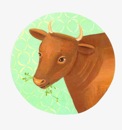
art by Giselle Potter
|
|
|
|
|
|